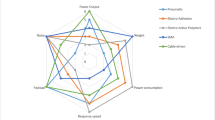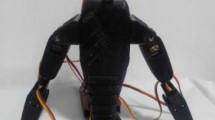Abstract
Dexterous in-hand manipulation with multi-finger robotic hands is a hot topic in robotics. Recently many famous multi-finger robotic hands have been developed. Though a lot of research has been done on them; in-hand manipulation is still a challenge. One of its issues lies in the uncertainty of interaction states. In this paper we research robot-object interaction from a novel angle called haptic exploration. This method helps robots acquire the ability to explore the robot-object interaction. In in-hand manipulation tasks, haptic exploration is a process where the robot pushes on in-hand objects slightly in different directions, and meanwhile perceives the haptic feedback to estimate the interaction state. In this paper a new single finger push model is proposed for analyzing the haptic feedback, which is similar to traditional impedance control of robot arm. In this model the stiffness of fingers, the deformation on contact surface, and the change of object’s pos (position and attitude) are considered. Furthermore, a push resistance is given to describe the haptic feedback acquired from a slight push. Finally, real robotic experiments are conducted to verify the feasibility of proposed method.
概要
概要
多指灵巧手的灵巧操作是一个非常重要的研究方向, 其中灵巧手和被操作物体间相对状态的感知是个具有挑战性的研究难题. 本文从灵巧手与物体之间相互作用的角度出发, 提出了一种触觉探索的感知方法. 在该方法中, 灵巧手指尝试沿不同的方向推动物体, 并在此过程中收集相关的触觉信息, 从而推断灵巧手和被操作物体之间的相对状态. 综合考虑手指推动过程中手指关节的刚度, 接触面的形变以及物体位置变化等重要因素, 本文给出了单指推动触觉感知模型, 分析推动方向和触觉反馈之间的联系. 相应的机器人实验结果表明本文提出的方法正确、 有效.
创新点
在机器人灵巧手的研究中提出了触觉探索的感知方法. 该方法将物体和手作为一个感知整体. 并在此基础上, 提出了单指推动的触觉感知模型.
Similar content being viewed by others
References
Kochan A. Shadow delivers first hand. Indl robot, 2005, 32: 15–16
Lovchik C, Diftler M A. The robonaut hand: a dexterous robot hand for space. In: Proceedings of the IEEE International Conference on Robotics and Automation (ICRA), Detroit, 1999. 907–912
Butterfass J, Grebenstein M, Liu H, et al. Dlr-hand ii: next generation of a dextrous robot hand. In: Proceedings of the IEEE International Conference on Robotics and Automation (ICRA), Seoul, 2001. 109–114
Bicchi A. Hands for dexterous manipulation and robust grasping: a difficult road toward simplicity. IEEE Trans Robotics Automat, 2000, 16: 652–662
Bicchi A, Kumar V. Robotic grasping and contact: a review. In: Proceedings of the IEEE International Conference on Robotics and Automation (ICRA), San Francisco, 2000. 348–353
Himoga K B. Robot grasp synthesis algorithms: a survey. Int J Robot Res, 1996, 15: 230–266
Okamura A M, Smaby N, Cutkosky M R. An overview of dexterous manipulation. In: Proceedings of the IEEE International Conference on Robotics and Automation (ICRA), San Francisco, 2000. 255–262
Khalil F F, Payeur P. Dexterous robotic manipulation of deformable objects with multi-sensory feedback-a review. In: Jimenez A, M Al Hadithi B, eds. Robot Manipulators Trends and Development. Croatia: InTech, 2010. 587–619
Senoo T, Yamakawa Y, Mizusawa S, et al. Skillful manipulation based on high-speed sensorymotor fusion. In: Proceedings of the IEEE International Conference on Robotics and Automation (ICRA), Anchorage, 2009. 1611–1612
Li Z, Hsu P, Sastry S. Grasping and coordinated manipulation by a multifingered robot hand. Intl J Robot Res, 1989, 8: 33–50
Furukawa N, Namiki A, Taku S, et al. Dynamic regrasping using a high-speed multifingered hand and a high-speed vision system. In: Proceedings of the IEEE International Conference on Robotics and Automation (ICRA), Orlando, 2006. 181–187
Garcia-Rodriguez R, Parra-Vega V. Rolling a dynamic object with a planar soft-fingertip robot arm. In: Proceedings of the IEEE International Conference on Intelligent Robots and Systems (IROS), Tokyo, 2013. 2472–2478
Peters J, Muelling K, Kober J, et al. Robot skill learning. In: Proceedings of European Conference on AI (ECAI), Montpellier, 2012. 40–45
Argall B D, Chernova s, Veloso M, et al. A survey of robot learning from demonstration. Robot Auton Syst, 2009, 57: 469–483
Schaedle S, Ertel E. Dexterous manipulation using hierarchical reinforcement learning. In: Proceedings of the IEEE International Conference on Robotics and Automation Workshop, Karlsruhe, 2013. 1–5
Kalakrishnan M, Righetti L, Pastor P, et al. Learning force control policies for compliant manipulation. In: Proceedings of the IEEE International Conference on Intelligent Robots and Systems (IROS), San Francisco, 2011. 4639–4644
Baier-Lowenstein T, Zhang J. Learning to grasp everyday objects using reinforcement-learning with automatic value cut-off. In: Proceedings of the IEEE International Conference on Intelligent Robots and Systems (IROS), San Diego, 2007. 1551–1556
Pelossof R, Miller A, Allen P. An svm learning approach to robotic grasping. In: Proceedings of the IEEE International Conference on Robotics and Automation (ICRA), Barcelona, 2004. 3512–3518
Gorce P, Rezzoug N. A method to learn hand grasping posture from noisy sensing information. Robotica, 2004, 22: 309–318
Kroemer O, Detry P, Piater J, et al. Combining active learning and reactive control for robot grasping. Robot Auton Syst, 2010, 58: 1105–1116
Robles-De-La-Torre G, Hayward V. Force can overcome object geometry in the perception of shape through active touch. Nature, 2001, 412: 445–448
Roberts K S. Robot active touch exploration: constraints and strategies. In: Proceedings of the IEEE International Conference on Robotics and Automation (ICRA), Tsukuba, 1990. 980–985
Allen P K, Michelman P. Acquisition and interpretation of 3-d sensor data from touch. IEEE Trans Robot Automat, 1990, 6: 397–404
Lederman S J, Klatzky R L, Hamilton C L, et al. Perceiving roughness via a rigid probe: psychophysical effects of exploration speed and mode of touch. Electron J Haptics Res, 1999, 1
Yoshioka T, Bensmaia S, Craig J, et al. Texture perception through direct and indirect touch: an analysis of perceptual space for tactile textures in two modes of exploration. Somatosens Motor Res, 2007, 24: 53–70
Lynch K M. The mechanics of fine manipulation by pushing. In: Proceedings of the IEEE International Conference on Robotics and Automation (ICRA), Ottawa, 1992. 2269–2276
Namiki A, Imai Y, Ishikawa M, et al. Development of a high-speed multifingered hand system and its application to catching. In: Proceedings of the IEEE International Conference on Intelligent Robots and Systems (IROS), Nevada, 2003. 2666–2671
Flash T. The control of hand equilibrium trajectories in multi-joint arm movements. Biol Cybern, 1987, 57: 257–274
Hogan N. The mechanics of multi-joint posture and movement control. Biol Cybern, 1985, 52: 315–331
Asada H, Slotine J-J E. Robot Analysis and Control. New York: Wiley, 1986
Kim B, Park J, Park S, et al. Impedance learning for robotic contact tasks using natural actor-critic algorithm. IEEE Trans Syst Man Cybern Part B-Cybern, 2010, 40: 433–443
Lipkin H, Patterson T. Generalized center of compliance and stiffness. In: Proceedings of the IEEE International Conference on Intelligent Robots and Systems (IROS), Raleigh, 1992. 1251–1256
Inoue T, Hirai S. Elastic model of deformable fingertip for softfingered manipulation. IEEE Trans Robot, 2006, 22: 1273–1279
Author information
Authors and Affiliations
Corresponding authors
Rights and permissions
About this article
Cite this article
He, J., Zhang, J. In-hand haptic perception in dexterous manipulations. Sci. China Inf. Sci. 57, 1–11 (2014). https://doi.org/10.1007/s11432-014-5216-3
Received:
Accepted:
Published:
Issue Date:
DOI: https://doi.org/10.1007/s11432-014-5216-3
Keywords
- in-hand manipulation
- multi-finger robotic hands
- dexterous manipulation
- haptic perception
- haptic feedback




